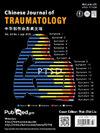Research of injury mapping relationship of lumbar spine in reclined occupants between anthropomorphic test devices and human body model
IF 1.9
4区 医学
Q2 ORTHOPEDICS
引用次数: 0
Abstract
Purpose
To judge the injury mode and injury severity of the real human body through the measured values of anthropomorphic test devices (ATD) injury indices, the mapping relationship of lumbar injury between ATD and human body model (HBM) was explored.
Methods
Through the ATD model and HBM simulation, the mapping relationship of lumbar injury between the 2 subjects was explored. The sled environment consisted of a semi-rigid seat with an adjustable seatback angle and a 3-point seat belt system with a seatback-mounted D-ring. Three seatback recline states of 25°, 45°, and 65° were designed, and the seat pan angle was maintained at 15°. A 23 g, 47 km/h pulse was used. The validity of the finite element model of the sled was verified by the comparison of ATD simulation and test results. ATD model was the test device for human occupant restraint for autonomous vehicles (THOR-AV) dummy model and HBM was the total human model for safety (THUMS) v6.1. The posture of the 2 models was adjusted to adapt to the 3 seat states. The lumbar response of THOR-AV and the mechanical and biomechanical data on L1 – L5 vertebrae of THUMS were output, and the response relationship between THOR-AV and THUMS was descriptive statistically analyzed.
Results
Both THOR-AV and THUMS were submarined in the 65° seatback angle case. With the change of seatback angle, the lumbar spine axial compression force (Fz) of THOR-AV and THUMS changed in the similar trend. The maximum Fz ratio of THOR-AV to THUMS at 25° and 45° seatback angle cases were 1.6 and 1.7. The flexion moment (My) and the time when the maximum My occurred in the 2 subjects were very different. In particular, the form of moment experienced by the L1 − L5 vertebrae of THUMS also changed. The changing trend of My measured by THOR-AV over time can reflect the changing trend of maximum stress of L1 and L2 of THUMS.
Conclusion
The Fz of ATD and HBM presents a certain proportional relationship, and there is a mapping relationship between the 2 subjects on Fz. The mapping function can be further clarified by applying more pulses and adopting more seatback angles. It is difficult to map My directly because they are very different in ATD and HBM. The My of ATD and stress of HBM lumbar showed a similar change trend over time, and there may be a hidden mapping relationship.
拟人化测试装置与人体模型对斜躺者腰椎损伤映射关系的研究
目的通过拟人试验装置(ATD)损伤指标的测量值判断真实人体的损伤模式和损伤严重程度,探讨ATD与人体模型(HBM)腰椎损伤的映射关系。方法通过ATD模型和HBM模拟,探讨两组受试者腰椎损伤的映射关系。雪橇环境包括半刚性座椅,座椅靠背角度可调,3点安全带系统,座椅靠背安装d环。设计了25°、45°和65°三种椅背后倾状态,座椅盘面角保持在15°。采用23 g, 47 km/h脉冲。通过ATD仿真与试验结果的对比,验证了滑橇有限元模型的有效性。ATD模型为自动驾驶汽车乘员约束试验装置(THOR-AV)假人模型,HBM为全人体安全模型(THUMS) v6.1。调整了2个模型的姿势,以适应3种座位状态。输出THOR-AV腰椎反应及THUMS L1 - L5椎体的力学和生物力学数据,描述性统计分析THOR-AV与THUMS的反应关系。结果在椅背角度为65°的情况下,THUMS和THOR-AV均成功下潜。随着坐背角度的变化,THOR-AV和THUMS腰椎轴向压缩力(Fz)的变化趋势相似。座椅靠背角度为25°和45°时,THOR-AV与THUMS的最大Fz比分别为1.6和1.7。两组受试者的弯曲弯矩(My)和最大弯矩发生的时间有很大差异。特别是THUMS的L1−L5椎体会到的力矩形式也发生了变化。THOR-AV测量My随时间的变化趋势可以反映THUMS L1和L2最大应力的变化趋势。结论ATD的Fz与HBM呈一定的比例关系,两种被试在Fz上存在映射关系。通过施加更多的脉冲和采用更大的椅背角度,可以进一步明确映射功能。很难直接映射My,因为它们在ATD和HBM上有很大的不同。ATD的My与HBM腰椎的应激随时间的变化趋势相似,可能存在隐藏的映射关系。
本文章由计算机程序翻译,如有差异,请以英文原文为准。
求助全文
约1分钟内获得全文
求助全文
来源期刊

Chinese Journal of Traumatology
ORTHOPEDICS-
CiteScore
3.80
自引率
4.80%
发文量
1707
审稿时长
28 weeks
期刊介绍:
Chinese Journal of Traumatology (CJT, ISSN 1008-1275) was launched in 1998 and is a peer-reviewed English journal authorized by Chinese Association of Trauma, Chinese Medical Association. It is multidisciplinary and designed to provide the most current and relevant information for both the clinical and basic research in the field of traumatic medicine. CJT primarily publishes expert forums, original papers, case reports and so on. Topics cover trauma system and management, surgical procedures, acute care, rehabilitation, post-traumatic complications, translational medicine, traffic medicine and other related areas. The journal especially emphasizes clinical application, technique, surgical video, guideline, recommendations for more effective surgical approaches.
 求助内容:
求助内容: 应助结果提醒方式:
应助结果提醒方式:


